#Thingsboard
Text
BLIIoT | BACnet gateway BA113 for Building Automation BACnet and Modbus Devices to Cloud
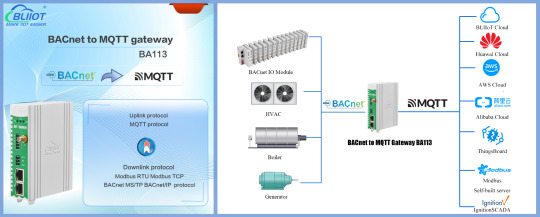
Introduction
With the development of communication technology and control technology, in order to achieve efficient and intelligent management of buildings, centralised monitoring and management has become an inevitable trend in the development of intelligent management of buildings. In this context, high-performance building HVAC data transmission solutions - protocol conversion gateway came into being, widely used in building automation and HVAC system applications.
BLIIoT always insists on the core of the user's needs, and constantly expands its applications in a variety of industrial fields. Recently, we have developed a new series of BLIIoT Building Automation HVAC gateways, This series of products not only have excellent stability and anti-interference capabilities, but also have deep industry applications, aiming to bring users a new building automation data collection and conversion experience.
Product Description
BACnet to MQTT gateway BA113 supports Modbus RTU, Modbus TCP, PLC, BACnet MS/TP, BACnet IP, and MQTT protocols.
BACnet to MQTT gateway BA113 hardware interface includes 2 or 6 RS485/RS232 serial ports, 2 network ports and 1 WiFi wireless transmission interface.
It not only supports mainstream cloud platforms (Alibaba Cloud, Huawei Cloud, Amazon AWS), but also integrates IoT platforms such as ThingsBoard, Ignition, and Zabbix to achieve seamless communication between devices and platforms.
The BACnet to MQTT gateway BA113 adopts an industrial-grade design to ensure reliability in harsh environments. Suitable for industrial automation systems, PLC remote monitoring and IoT applications, BA113 connects the future of industry and provides users with reliable BACnet device networking solutions.

By using BLIIoT patented guide rail buckle technology, the installation process is simplified and the practicality of the gateway is ensured.
Product features
Supported protocols:
Downlink protocol: Modbus RTU, Modbus TCP, BACnet MS/TP, BACnet IP.
Uplink protocols: MQTT.
Hardware interface:
6*RS485/RS232 serial ports: The serial ports are independent of each other. Each serial port parameter can be set to collect different protocols. The serial port can also set the master-slave relationship independently. It can be configured as either a master station or a slave station.
2*network ports: used for data collection and forwarding. The LAN port has a routing function and provides a channel for other devices to connect to the external network.
4G or WiFi wireless transmission interface: Provides diverse communication options to adapt to different industrial environment need.
Data security:
Support data TSL/SSL, X.509 certificate, SNMP V1/V2, key encryption and other security gateway functions.
Remote Configuration Support:
Support remote configuration, providing users with convenient management and monitoring methods, no longer need to visit engineers, saving maintenance costs.
Product Size: L x W x H: 30 x 83 x 110mm
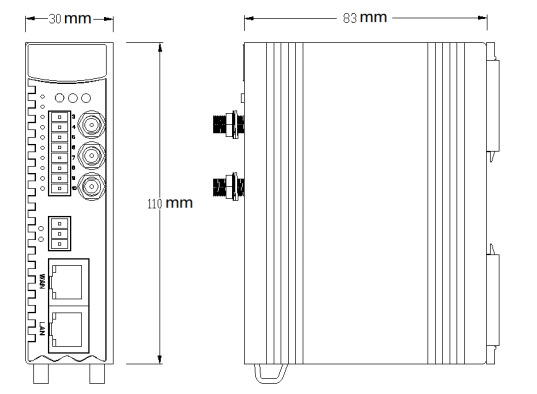

Safety and Stability:
Industrial-grade design: Durable shell material meets industrial environment requirements.
Stability: Efficient communication protocol conversion ensures stable operation of the system.
Environmental adaptation:
Operating temperature range: -40~80℃, adapting to various industrial environments. Protection grade: IP30, ensuring the reliability of the equipment in harsh environments.
Model List

Application scenarios

BA113 is widely used in building automation-related Modbus and BACnet devices to provide stable and reliable solutions to the cloud.
More information about BACnet to MQTT Gateway BA113: https://www.bliiot.com/industrial-iot-gateway-p00424p1.html
#IoT#IoT Solution#Smart Building#BMS#BAS#HVAC#MQTT#BACnet MS/TP#BACnet/IP#Ignition#SCADA#Thingsboard#AWS#Huawei cloud#Ali Cloud#BLIIoT
0 notes
Text
BLIIoT Water Meter Pulse Counting Gateway S271

Background
No matter where you live, water and electric meters are an absolute must. Water meters record how much water you use and how much you pay for it. Water meters help monitor data, conserve water, and lower water bills.
Pulse Counting Gateway
Pulse Counting Gateway S271 is designed to count the number of pulses from electricity meters, water meters or general meters as well as machinery and equipment with pulse outputs. Quickly and cost-effectively transform your traditional water meter into a smart water meter, monitoring data in real time.
Solution
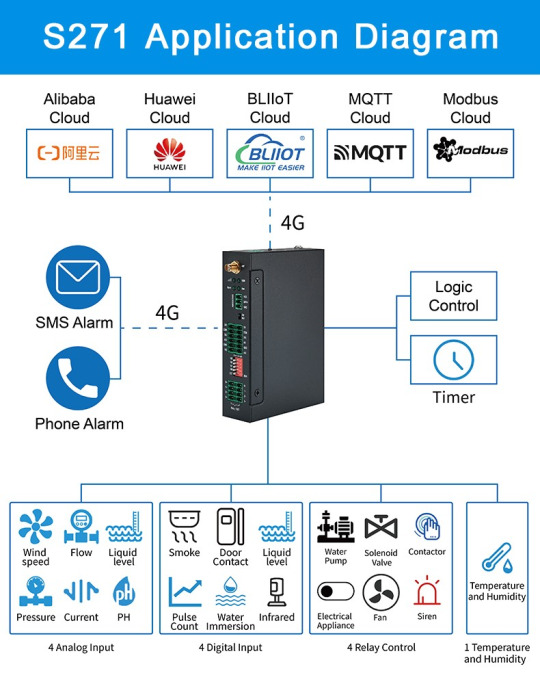
Pulse Counting Gateway S271 can be used in different applications such as agricultural irrigation, smart building meter reading and industrial water use. The device can be connected to a pulse water meter, and then collect water use data and upload the data to the IoT cloud platform via 4G for further visualization. Users can check the status of the water meter and perform monitoring and control at any time. The pulse counter can provide remote monitoring and visual intelligent data management to achieve water conservation.
More information about Water Meter Pulse Counting Gateway S271: https://www.bliiot.com/m2m-rtu-p00175p1.html
0 notes
Text

Messing with ThingsBoard CE local server, a quartet of ESPs & DHT22s. Using IFTTT to trigger humidifiers, pellet stove, and space heaters. I want winter to be over...
What we do
0 notes
Text
Smart Dashboards – Avigna
IoT dashboard - Welcome to Avigna Smart Dashboards. Imagine having your IoT devices at your fingertips, offering real-time insights and control. That’s what our Smart Dashboards bring to the table – a smarter, more connected world for you.

An IoT (Internet of Things) dashboard is a visual interface that allows users to monitor and manage connected devices and data in real-time. These dashboards play a crucial role in IoT applications by providing a centralized platform to view, analyze, and control various aspects of connected devices and systems. Here are some key features and components commonly found in IoT dashboards:
Device Overview:
Display a summary of all connected devices.
Provide information on device status, such as online/offline, and health.
Real-time Data Visualization:
Present real-time data from sensors or devices in the form of charts, graphs, or gauges.
Enable users to quickly interpret data trends and make informed decisions.
Alerts and Notifications:
Set up alerts for abnormal conditions or events.
Receive notifications through the dashboard or other communication channels
Device Control:
Allow users to remotely control connected devices.
Implement functionalities like turning devices on/off, adjusting settings, etc.
Historical Data Analysis:
Provide tools for analyzing historical data.
Support data filtering, time-based analysis, and trend identification.
User Authentication and Authorization:
Implement secure login mechanisms to ensure only authorized users can access the dashboard.
Assign different levels of access based on user roles.
Geospatial Visualization:
If applicable, display the geographical location of devices on a map.
Enable users to interact with devices based on their physical location.
Customization:
Allow users to customize the dashboard layout and choose the specific data they want to monitor.
Support configurable widgets and layouts.
Integration with Other Systems:
Integrate with external systems or third-party services for a comprehensive view of data.
Provide APIs for easy integration with other applications.
Security:
Implement robust security measures to protect data and ensure the privacy of users.
Use encryption, secure protocols, and follow best practices for IoT security.
Scalability:
Design the dashboard to handle a growing number of devices and data points.
Ensure scalability to accommodate future expansions.
Popular tools and platforms for creating IoT dashboards include Grafana, ThingsBoard, Ubidots, and others. The choice of platform often depends on specific project requirements and the underlying IoT ecosystem.
Website: - https://avigna.ai/smart-dashboards/
0 notes
Text
Take BL101 as an example to illustrate what is Modbus gateway
An Industrial IoT Modbus gateway is a device that connects Modbus-based devices in an industrial environment to an IoT (Internet of Things) network. BL101 is a typical Modbus gateway from BLIIoT. Here's a breakdown of the key components and functionalities:
Modbus Protocol: Modbus is a commonly used communication protocol in industrial settings that allows devices, such as sensors, actuators, and controllers, to communicate and exchange data.
Gateway Functionality: The gateway acts as an intermediary between the Modbus devices and the larger IoT network. It allows Modbus devices to communicate with IoT platforms, cloud services, or other connected systems. As BL101, it can connect to devices via Modbus protocol and upload data to the could platform.

Data Conversion: The gateway typically performs data conversion tasks, as Modbus data formats may differ from those used in IoT platforms. It translates Modbus data into a compatible format, such as JSON or MQTT, allowing seamless integration with IoT systems. BL101 supports Modbus RTU, Modbus TCP, DL/T645 to MQTT, OPC UA, Modbus TCP protocol conversion.

Connectivity: Industrial IoT Modbus gateways offer various connectivity options, including wired connections like Ethernet or RS-485, or wireless options like Wi-Fi, Bluetooth, or cellular networks. This flexibility enables connecting to Modbus devices in diverse industrial environments. BL101 provides 1 RS-485/RS-232, 2 RJ-45 and 4G network, and acquires 4000 data points from 100 devices by Ethernet and Serial Ports.
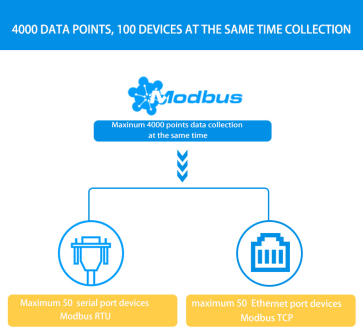
Security and Protocol Support: As industrial environments require stringent security measures, these gateways often incorporate advanced security features such as encryption, authentication, and firewall capabilities. About BL101, it supports data TSL/SSL, X.509 certificate, key encryption, OpenVPN, APN private network, offline caching and other security gateway features. Also, it supports Software/Hardware watchdog with high reliability. Additionally, they support various Modbus protocols, such as Modbus TCP/IP or Modbus RTU, to accommodate different devices.
Data Management and Analysis: Once the Modbus devices are connected to the IoT network through the gateway, the data can be uploaded to the could platform and managed, analyzed, and acted upon. However, BL101 supports Huawei IoT, Alibaba IoT, ThingsBoard, Ignition SCADA, SparkplugB, DCS, MES, BLIIoT cloud, etc. This enables industrial businesses to carry out real-time monitoring, predictive maintenance, data analytics, and other IoT-related applications.
By utilizing an Industrial IoT Modbus gateway, businesses can leverage their existing Modbus infrastructure while integrating it with modern IoT networks, allowing for more efficient industrial automation, monitoring, and control.
0 notes
Text
New scalable, fault-tolerant, and efficient open-source MQTT broker
https://github.com/thingsboard/tbmq
0 notes
Text
0 notes
Text
BL103UA Energy monitoring BACnet to MQTT 2RJ45 Industrial IoT gateway
BACnet gateway BL103 is a cost-effective industrial IoT Gateway, for building automation and HVAC control systems, which is used to convert BACnet MS/TP to BACnet/IP, Modbus to BACnet/IP, BACnet to MQTT, BACnet to OPC UA protocol.
BACnet gateway BL103 adopts embedded ARM MCU, based on Linux OS, equipped with 1WAN/LAN, 1LAN, 1 RS485, 4G module optional.
BACnet gateway BL103 has powerful protocol conversion function, which can realize simultaneous acquisition of multiple protocols, including: BACnet MS/TP, BACnet/IP, Modbus RTU, Modbus TCP, DLT645. Upstream supports BACnet/IP, Modbus TCP, MQTT, OPC UA It has built-in cloud drivers such as Huawei Cloud, Alibaba Cloud, KPIIOT, Amazon Cloud, Thingsboard Cloud, and Sparkplug B, which can be directly connected to various mainstream cloud platforms.
BACnet gateway BL103 supports OPENVPN network security protection protocol, is compatible with TLS SSL X.509 root certificate and other data encryption technologies to ensure data security.
Moreover, BACnet Gateway BL103 adopts the unique data integrity technology of breakpoint data supplementary transmission.
BACnet gateway BL103 integrates the user-friendly configuration interface, as well as functions such as remote configuration and remote firmware upgrade;
The BACnet gateway BL103 adopts a fastened structure, redundant power supply design, and can be installed on a standard DIN35 rail.
0 notes
Text
开源物联网平台-ThingsBoard
ThingsBoard是一款开源的物联网平台,可实现物联网项目的快速开发,设备管理和扩展。 遵守Apache2.0开源协议。支持任意数量设备的数据发送到云服务器,在云服务器中可以通过可自定义的仪表板查看或共享。 Thingsboard支持提供设备连接的标准协议是MQTT,CoAP和HTTP,并支持云和本地部署。支持多租户安装即装即用, 提供了30多个可自定义的小部件,实现监视客户端和提供服务器端设备属性。


功能特色:
遥测数据收集:以可靠的方式收集和存储遥测数据,以应对网络和硬件故障。 使用可自定义的Web仪表板或服务器端API访问收集的数据。
多租户:开箱即用地支持多租户安装。 单个租户可支持多个租户管理员以及数百万个设备和客户。
数据可视化:提供30多种可立即配置的小部件,并能够使用内置编辑器创建自己的小部件。 内置线图,数字和模拟仪表,地图等等。
横向可扩展性:随着以群集模式添加新的Thingsboard服务器,受支持的服务器端请求和设备的数量呈线性增加。 无停机时间,服务器重启或应用程序错误。
物联网规则引擎:根据实体属性或消息内容,使用灵活的规则链处理传入的设备数据。 使用自定义逻辑将数据转发到外部系统或触发警报。 在警报上配置复杂的通知链。 增强服务器端功能或使用高度可定制的规则来操作设备。 使用拖放规则链设计器定义应用程序逻辑。
容错性:所有Thingsboard服务器都是相同的。 不需要主要工作人员或热备用人员。 自动检测到节点故障。 可以在不停机的情况下更换发生故障的节点。 使用可靠的NoSQL数据库复制持久数据。
设备管理:提供注册和管理设备的功能。 允许监视客户端和供应服务器端设备属性。 为服务器端应用程序提供API,以将RPC命令发送到设备,反之亦然。
资产管理:提供注册和管理资产的功能。 允许供应服务器端资产属性并监视相关警报。 使用关系建立实体层次结构的能力。
警报管理:提供创建和管理与您的实体(设备,资产,客户等)相关的警报的功能。允许实时警报监视以及将警报发送到相关实体层次结构。 在设备断开连接或不活动事件时发出警报。
安全性:支持MQTT和HTTP协议的传输加密。 支持设备认证和设备凭证管理。
支持定制与整合:使用可自定义的规则链,小部件和传输实施扩展默认平台功能。 除了MQTT,CoAP和HTTP支持之外,ThingsBoard用户还可以使用自己的传输实现或自定义现有协议的行为。
支持SQL,NoSQL和混合数据库:支持各种数据库选项,可分别存储主要实体以及遥测数据
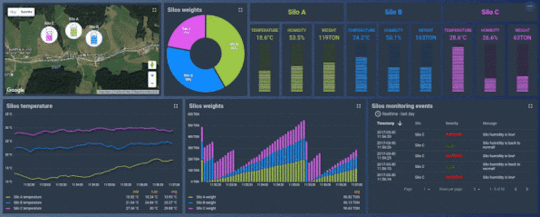
https://github.com/thingsboard/thingsboard
开源物联网平台-ThingsBoard was originally published on 开源派
1 note
·
View note
Text
BLIIoT 4G Industrial Edge Router R40B Integrated Concrete Mixing Station Monitoring System
LIIoT 4G industrial edge router R40B supports 2DIN+2DO+4AI+logic control+Modbus to MQTT. It is used with sensors in concrete mixing stations to monitor air quality, temperature, pressure, etc., and uploads data to the cloud through wifi to achieve remote monitoring, and supports GPS and POE access to cameras for real-time monitoring of the on-site environment.

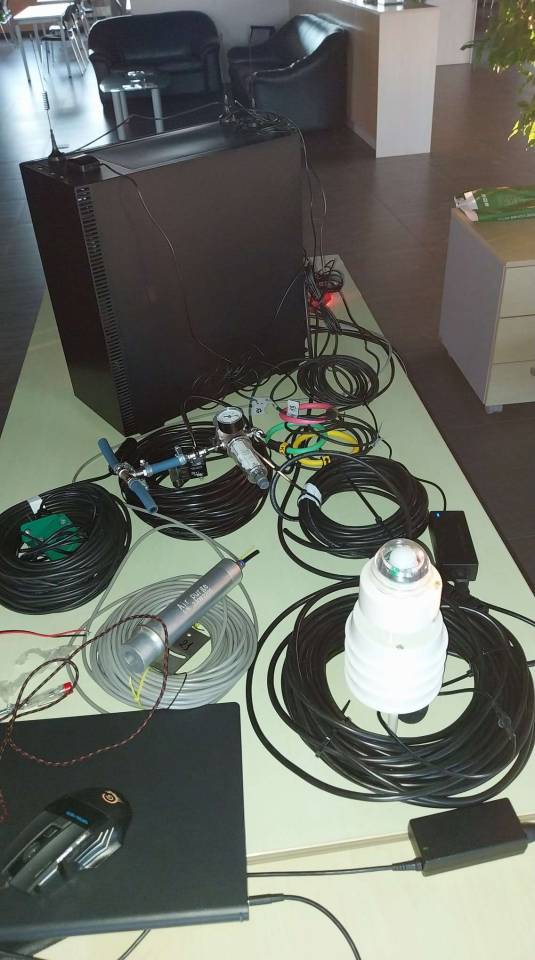
0 notes
Text
BLIIoT Air Compressor Remote Monitoring Solution

Background
As a large mechanical equipment, air compressors will generate a lot of after-sales maintenance and troubleshooting needs during long-term use. High power consumption and maintenance costs amplify the impact of failures, which can result in significant losses through delayed repairs and extended downtime.
By making air compressors IoT-enabled, maintenance personnel can remotely monitor compressor operation, detect abnormalities in a timely manner and proactively solve problems. This strategy minimizes downtime-related losses, enriches customer service, and enhances the overall value proposition.
Air compressor monitoring requirements
Real-Time Monitoring and Remote Control
Through real-time collection of key parameters such as temperature, pressure, and rotational speed of the air compressor. Allows remote control to adjust parameters and optimize production processes.
Troubleshooting and Predictive Maintenance
Analyze collected data and diagnose potential machine failures, issuing timely alerts to prevent production interruptions and equipment damage.
Data Analysis and Reporting
Advanced data analytics platforms are required to process, analyze and visualize machine operation data. It should support report and chart generation, allowing customers to monitor production efficiency, quality metrics, equipment utilization and drive continuous improvement.
Application of RTU S275 in Remote Monitoring of Air Compressors

Data collection and monitoring
Through RTU S275, we can easily configure oil temperature and lubricant level sensors to monitor key parameters of the air compressor in real time. The equipment provides data storage and historical recording functions to ensure the traceability of production data.
Air compressor controller connection
RTU S275 can establish a connection with the air compressor controller to realize real-time monitoring and remote control of the air compressor status. In this way, operators can adjust operating parameters in a timely manner to optimize production efficiency.
4G network transmission
The device supports 4G network communication and transmits the collected data to the remote management platform in a dedicated protocol format. This ensures efficient transmission and real-time performance of data.
Remote visualization and analysis
The remote management platform receives, parses and stores data transmitted through RTU S275, providing customers with a convenient way to view, count and analyze data anytime and anywhere through a computer or mobile phone. This provides more intuitive and real-time data support for production management.
Security
To ensure the security of data transmission and storage, RTU S275 provides multiple security measures, including data encryption and authentication. These measures help prevent unauthorized access and ensure data integrity.
In conclusion
RTU S275 provides an intelligent solution for remote monitoring of air compressors. Its powerful functions and flexible configuration make it suitable for various industrial environments. Through real-time monitoring and remote control, RTU S275 not only improves the safety and reliability of the air compressor system, but also reduces maintenance costs and production risks.
More information about BLIIoT Remote Monitoring RTU Gateway S275 : https://www.bliiot.com/m2m-rtu-p00175p1.html
0 notes
Text
Open IoT Platform Industry Size, Share, Trends, Regional Analysis and Segmentation By Key Companies | Coronavirus Effects
Market Highlights
The global open IoT platform market 2020, according to MRFR, is poised to reach roughly USD 5.96 billion by 2025, expanding at 15.5% CAGR over the review period (2019—2025).
Market Scenario
In this rapidly changing world of technology, open IoT platform market is projected to show major growth prospects during the forecast period. An IoT platform combines several software functions into one solution to enable companies to develop and deploy IoT solutions faster, better and cheaper.
As compared to other regions, the open IoT platform market in North America is expected to witness significant growth and hold the largest market share during the forecast period. U.S and Canada are anticipated to drive the growth of open IoT platform market. This is owing to the presence of large number of established key players and increasing popularity among the developer community in that region. In addition to this, the region also has a well-established infrastructure and is expected to be a major factor for the growth of open IoT platform market.
Get a Free Sample @ https://www.marketresearchfuture.com/sample_request/3896
Segmentation:
The global market for the open IoT platform was segmented into component, deployment, organizational size and vertical industry.
The global open IoT platform market was segmented by component into hardware, software, and services. The services segment was further classified as professional and managed services.
The market was categorized by deployment into cloud (private, public, and hybrid) and on-premise.
The global open IoT platform market was segmented into SMEs and large organizations by organization size
By vertical industry the market was divided into government, healthcare, education, manufacturing, retail, electricity & utilities, automotive, and IT & Telecom.
Regional Analysis
The global open IoT platform market, by geography, has been segmented into North America, Europe, Asia Pacific and Rest of the World. In the global Open IoT platform market, Asia Pacific is anticipated to witness relatively faster adoption and is expected to grow at the highest CAGR during the forecast period as compared to other regions. Within Asia Pacific, open IoT platform market is projected to contribute faster to the growth of revenue backed by increasing demand from developers in countries such as Japan, China and India.
Across Europe, countries including Germany, France and the U.K. are anticipated to drive the growth of open IoT platform market. In Europe, the popularity of open source platforms is increasing among the developers and hence is the major factor driving the growth of open IoT platform market. The presence of advanced infrastructure and with the increasing adoption of open source applications and technological advancements in numerous countries are other factors driving the growth of open IoT platform market.
Open IoT platform market in the South America region is anticipated to witness relatively slower market growth. However, Brazil and Argentina among other countries are projected to witness slow yet steady growth. Open IoT platform market in Middle East and Africa occupies a relatively smaller pie of the global open IoT platform market.
Competitive Dashboard
Some of the main players of open IoT platform market includes IBM Corporation (US), The ThingsBoard Authors (US), Microsoft Corporation (US), Samsung (South Korea), Ayla Networks Inc. (US), Bosch (Germany), Google, Inc (US), General Electric (US), KaaIoT Technologies, LLC. (US), Oracle Corporation (US), SiteWhere LLC (US), Italtel SpA (Italy), Siemens AG (Germany), Thinger.io(Europe), and WSo2 (US)
Browse Complete Report @ https://www.marketresearchfuture.com/reports/open-iot-platform-market-3896
Open IoT Platform Market Research Report: By Component (Hardware, Software, Service [Professional Services, Managed Services]), Deployment (Cloud [Public Cloud, Private Cloud, Hybrid Cloud] and On-Premise), Organization Size (SMEs and Large Enterprise), and Industry Vertical (Government, Healthcare, Education, Manufacturing, Retail, Power & Utilities, Automotive, IT & Telecom), and Region (North America, Europe, Asia Pacific, the Middle East & Africa, and South America) - Forecast till 2027
About Market Research Future:
At Market Research Future (MRFR), we enable our customers to unravel the complexity of various industries through our Cooked Research Report (CRR), Half-Cooked Research Reports (HCRR), Raw Research Reports (3R), Continuous-Feed Research (CFR), and Market Research & Consulting Services.
MRFR team have supreme objective to provide the optimum quality market research and intelligence services to our clients. Our market research studies by products, services, technologies, applications, end users, and market players for global, regional, and country level market segments, enable our clients to see more, know more, and do more, which help to answer all their most important questions.
Contact:
Market Research Future
+1 646 845 9312
Email: [email protected]
0 notes
Text

BL110 IIoT gateway comes with 4 serial ports and 2 network ports. Support various PLC protocols, Modbus RTU, Modbus TCP, DL/T645, BACnet/IP, BACnet MS/TP to Modbus TCP, OPC UA, MQTT, BACnet/IP protocol conversion, Huawei IoT, Alibaba IoT, AWS, ThingsBoard, Sparkplug B, Ignition SCADA, BLIIoT Cloud. Support custom secondary development.
PLC, BACnet/IP, BACnet MS/TP, Modbus RTU/TCP, DL/T645 to BACnet IP, Modbus TCP, MQTT, OPC UA; Huawei IoT protocol conversion, Alibaba IoT, ThingsBoard, Ignition SCADA, SparkplugB, DCS, MES, BLIIoT cloud, etc.;
Acquiring 4000 data points from 100 devices by Ethernet and Serial Ports;
Data mapping acquisition and control, transparent transmission and other operating modes;
Connecting 7 cloud platforms and local host systems at the same time;
Support data SSL TLS, X.509 certificate, key encryption, Open VPN, APN private network, offline caching and other security gateway features;
Integrated router function to provide network to other devices;
GPS positioning function for easy understanding of equipment distribution and maintenance;
PLC program remote upload and download, easy to debug PLC;
Offline cache backup, network recovery replenishment transfer to ensure data integrity;
Supports the establishment of trusted and secure connections through Open VPN channels to ensure secure data transmission;
Active reporting, regular reporting, also has data threshold abnormal alarm, linkage trigger control;
With local edge task management, flexible setting of gateway timed restart, timed trigger switch type control on and off;
Multi-topic publishing, free to choose different data points to upload to different IoT platforms;
Wireless remote firmware upgrade;
APN private network access;
Cellular signal value monitoring;
Support software and hardware watchdog, high reliability.
Support protocol custom development to meet non-standard equipment data acquisition.
0 notes
Text
Open IoT Platform Market Sales Revenue, Comprehensive Plans, Growth Potential & Forecast 2020-2027 | COVID-19 Impact
Market Highlights
The global open IoT platform market 2020, according to MRFR, is poised to reach roughly USD 5.96 billion by 2025, expanding at 15.5% CAGR over the review period (2019—2025).
Market Scenario
Over the forecast era, the open IoT platform market is expected to show significant growth prospects in this rapidly evolving environment of technology. Reduction of the costs of connected devices and continuous technical development are some of the key factors fueling the growth of the open IoT platform industry. Additional factors driving the growth of open IoT application market are developing developer skills and learning new technologies. Data security and privacy concerns are, however, the factor that hampers market growth over the forecast period.
Segmentation:
The global open IoT platform market was segmented into component, deployment, organizational size and vertical industry.
The global open IoT platform market was segmented by component into hardware, software, and services. The services segment was further classified as professional and managed services.
The market was categorized by deployment into cloud (private, public, and hybrid) and on-premise.
The global open IoT platform market was segmented into SMEs and large organizations by organization size
By vertical industry the market was divided into government, healthcare, education, manufacturing, retail, electricity & utilities, automotive, and IT & Telecom.
Regional Analysis
The global open IoT application market regional research is being studied for Asia-Pacific, Europe, Middle East & Africa, North America and South America.
Thanks to the prevalence of early adopters of the new technologies in this area North America dominates the global open IoT platform segment. The growth is also attributed to the involvement of a large number of existing core players such as Google, Inc., IBM Corporation, and Oracle Corporation leading this region's open IoT platform market. In addition, the demand is also driving the growing popularity among the developer community in that region. The area also has a well-established infrastructure in addition to this, and is expected to be a key factor in the development of the open IoT platform sector. In addition, the growth of the North American open IoT platform market is due to the growing popularity among the region's developers. Those are some of the aspects that are responsible for the growth of the region's global open IoT platform market over the forecast period.
Countries throughout Europe include Germany, France and Great Britain. Growth of the open IoT network market is expected. In Europe, the popularity of open source platforms among developers is growing, and is therefore the key factor driving the growth of open IoT platform market. Other factors driving the growth of the open IoT platform market are the emergence of advanced technology, and the rising acceptance of open source software and technological developments in various countries.
Over the forecast period Asia Pacific expects to hit the highest CAGR on the global open IoT platform market. This is due to the presence in the area of leading giants like Samsung and Ericsson. In addition, that collaborations between key players help speed up the delivery of IoT services and solutions in the area. Another aspect responsible for the growth of the demand for the open IoT platform is early adoption of smart connected devices.
Competitive Dashboard
Some of the main players of open IoT platform market includes IBM Corporation (US), The ThingsBoard Authors (US), Microsoft Corporation (US), Samsung (South Korea), Ayla Networks Inc. (US), Bosch (Germany), Google, Inc (US), General Electric (US), KaaIoT Technologies, LLC. (US), Oracle Corporation (US), SiteWhere LLC (US), Italtel SpA (Italy), Siemens AG (Germany), Thinger.io(Europe), and WSo2 (US)
0 notes
Text
BL103E Security monitoring 2RJ45 BACnet Industrial IoT gateway
BACnet gateway BL103 is a cost-effective industrial IoT Gateway, for building automation and HVAC control systems, which is used to convert BACnet MS/TP to BACnet/IP, Modbus to BACnet/IP, BACnet to MQTT, BACnet to OPC UA protocol.
BACnet gateway BL103 adopts embedded ARM MCU, based on Linux OS, equipped with 1WAN/LAN, 1LAN, 1 RS485, 4G module optional.
BACnet gateway BL103 has powerful protocol conversion function, which can realize simultaneous acquisition of multiple protocols, including: BACnet MS/TP, BACnet/IP, Modbus RTU, Modbus TCP, DLT645. Upstream supports BACnet/IP, Modbus TCP, MQTT, OPC UA It has built-in cloud drivers such as Huawei Cloud, Alibaba Cloud, KPIIOT, Amazon Cloud, Thingsboard Cloud, and Sparkplug B, which can be directly connected to various mainstream cloud platforms.
BACnet gateway BL103 supports OPENVPN network security protection protocol, is compatible with TLS SSL X.509 root certificate and other data encryption technologies to ensure data security.
Moreover, BACnet Gateway BL103 adopts the unique data integrity technology of breakpoint data supplementary transmission.
BACnet gateway BL103 integrates the user-friendly configuration interface, as well as functions such as remote configuration and remote firmware upgrade;
The BACnet gateway BL103 adopts a fastened structure, redundant power supply design, and can be installed on a standard DIN35 rail.

0 notes